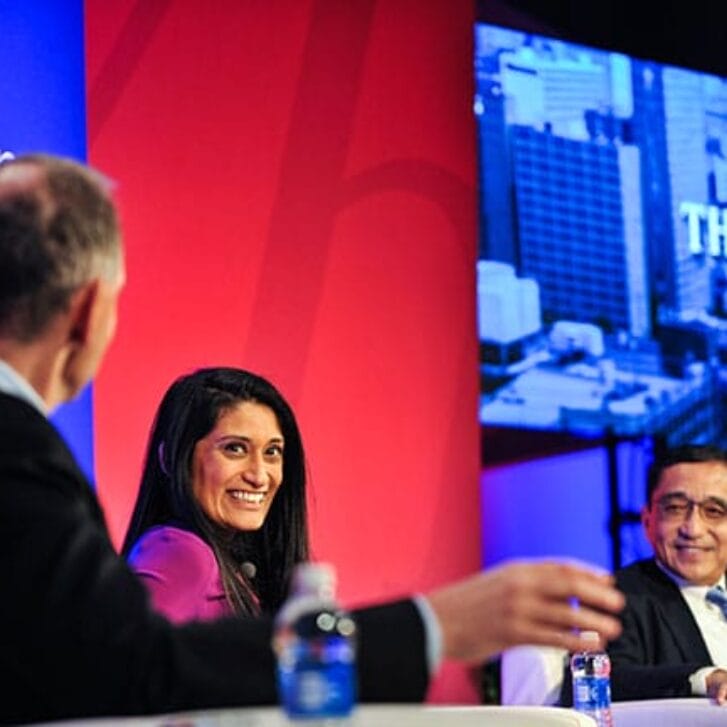It was a weekday morning in December 2009, and I awoke with a general feeling of “blah” hanging over me. I couldn’t figure out what was zapping me of my drive. For most of my almost 20-year career, I had been a self-motivated corporate executive, climbing determinedly up the corporate ladder toward nirvana—or so I thought. It seemed that with every rung I reached, the euphoria evaporated a little sooner. I was like a junkie; my drug of choice—achievement—was no longer giving me the high I wanted. To the outside world, everything looked just great. Then why wasn’t I jumping for joy? What was missing?
I realized I was in a full-blown midlife crisis (a little early, actually!), and a part of me was missing. I call her my inner Dancing Queen. She’s the part of me that stands up for me. I imagine her in disco boots and a bright orange satin jumpsuit with sequins, underneath a spinning disco ball. Dancing Queen urged me to slow down, to look deeper within myself, and to stand up for my own fulfillment. I realized slowing down was a challenge because it forced me to face my discontentment. I had been telling myself a few lies over the years about who I really was—ignoring my emotions, the need to slow down, to take a break and care for myself. There had been too many days since I had used my creativity. Instead, I was reviewing my 10th version of a PowerPoint presentation for an upcoming meeting.
I was burned out. I wasn’t being authentic.
There’s a great book by Bronnie Ware, a hospice nurse, called The Top Five Regrets of the Dying. In it, she asks patients on their deathbeds, at the time where they can perhaps see most clearly the value of life, about their greatest regrets. Their number one regret: “I wish I’d had the courage to live a life true to myself, not the life others expected of me.”
Being true to ourselves is about having the courage to define our own version of what it is to live a successful life. For me, it’s about making peace between that hard-charging, results-driven executive who still wants to achieve and the peace-and-love hippie who wants to hang out in an ashram and dreams of a better planet for all. As soon as we limit ourselves, we may achieve success, but not fulfillment, because we aren’t living out our important truths.
Consider the polygraph test, which tells the person administering it whether you’re lying. How does it know? Lying causes stress in the body. As part of the test, six nodes are attached to the body to measure vital signals. When you lie, the detector shows significant changes in physiological responses: a faster heart rate, higher blood pressure, increased perspiration. Telling a lie creates stress in the body, and research shows that continuous stress can contribute to the development of major illnesses such as heart disease, depression and obesity. I suspect that hiding the truth about ourselves or suppressing parts of who we are creates similar stresses in our bodies.
You might say we’re simply wired to tell the truth. Leaders rooted in authenticity create enormous benefits for themselves, those they lead, and their organizations overall.
Authentic Connections Are Good for Our Well-Being
Authenticity also helps us build deeper connections with others. In her book Love 2.0: How Our Supreme Emotion Affects Everything We Feel, Think, Do, and Become, psychologist Barbara Fredrickson redefines love not as “a stable behemoth” but as micromoments of connection between people: “We each carry an intricate machinery of love, calibrating and attuning our moods and bodies to one another.”
Fredrickson’s research shows that our capacity for experiencing connection is linked to our health and longevity. Authentic connections with others build the health of our vagus nerve, the main nerve that originates at the stem of the brain and travels through the chest, connecting the brain to the lungs, the digestive tract and, most notably, the heart.
People with high vagal tone are typically happier, less stressed, and less likely to suffer from depression. They also have better memories, are better able to focus their attention, and have increased brainpower. Studies also show that these people who are able to experience authentic connections are usually healthier, as the vagus nerve is involved in insulin production, cardiovascular health and immune responses.
How do we build these authentic connections? We let our guards down. We step into our authentic selves to seek to see the human beings behind the labels we attach to ourselves and others. Being with others in this way eight to 10 hours a day is good for our health, perhaps even more than the company gym or health-care plan. (Yes, that’s the peace-and-love hippie in me talking.)
Creating Trust
In our flattening hierarchies, it’s more important than ever to be able to influence others who don’t report to us. Studies show that productivity, revenue and profits are linked to the level of trust in the organization. Trust is the key factor in how well people work together, listen to each other, and build effective relationships. Author and leadership guru Ken Blanchard reinforces this point in his study of more than 1,000 leaders. Fifty-nine percent said they left their company due to trust issues, citing lack of communication and dishonesty. Leaders who create trust are honest and transparent and follow through on promises they make. I believe trust can only be built when we are practicing authenticity.
Driving Innovation
Innovation is the lifeblood of all organizations—and not just in R&D. Innovation must flow across the spectrum of all our value-creation activities, in every single function and at every single level. What if all employees came to work thinking about how they could best innovate, contribute and bring their utmost talent to the workplace that day? Richard Branson, founder of Virgin, is a master at this: “Innovation happens when people are given the freedom to ask questions and the resources and power to find the answers.” His company has demonstrated disruptive innovation in many industries, from music to mobile phones to an ambitious undertaking in commercial space travel—but not without failure.
When Virgin Galactic’s SpaceShipTwo crashed in its experimental flight, one test pilot died, and another suffered serious injuries. Both had dedicated their careers and lives to working toward what was previously impossible—advancing safe travel into space.
Acknowledging their courage, Branson promised that Virgin Galactic “will not push on blindly. We’re going to learn from what went wrong, discover how we can improve safety and performance, and then move forward together.” Is he giving up on the dream? No. Branson said the company’s goal is still putting people safely into space: “I think millions of people in the world would love one day to have the chance to go to space, and this is the start of a long program.”
Authenticity allows us to engage with each other in powerful dreams that make the impossible possible. We are called on to persevere despite failure and pursue a purpose beyond the paycheck. This is at the core of innovation.
Building Great Customer Experiences
Professional-services organizations in which talent is a significant source of differentiation and competitive advantage, such as consulting firms or high-touch customer-service-oriented companies, can create significant value through the practice of authenticity.
Studies conducted by Ernst & Young on engagement teams globally show that companies in which employees rate highly their ability “to be fully themselves” in their work environment experience greater client satisfaction ratings and stronger client retention.
Inspiring Engagement in Organizations
According to a 2014 KPMG study, a staggering 93 percent of respondents said their organizations are considering or currently undergoing business transformation. Restructuring is the new normal. It creates fear and stress in organizations, undermining employee engagement. Yet successful restructuring requires high engagement—a tough paradox for leaders. Their authentic behaviors are the key to operating in this paradox.
The spread of social media creates transparency in the organization at a level we’ve never witnessed before. Now, a single employee having a bad day can create significant risk to a company’s reputation through a 140-character tweet or a video gone viral. Reputation impacts consumer and investor decisions. Increasingly, more of those investors are studying the Trust Index Employee Survey to assess the culture in organizations.
The bottom line is that the motivation and engagement of each employee count. Many organizations have put proactive initiatives in place to measure employee engagement. The needle is moving north, but not fast enough. Employee engagement measures the degree to which we’re excited about the work we’re doing, whether we feel connected with our co-workers, and whether our bosses care for our well-being and success.
The latest Gallup employee engagement research, conducted in 2012, showed that the top quartile of the 192 companies with the highest engagement numbers have 37 percent less absenteeism, 25 percent lower turnover, 21 percent higher productivity and 22 percent higher profitability.
Impacting Talent Retention
All this research into the motivation and engagement of workers shows that leaders who are trustworthy and transparent truly do make a difference—even more so in times of crisis and change. These leaders create organizational cultures not by what they say but by what they practice. Jennifer Hayes, partner at consulting firm Bain & Company, which has been recognized as one of the best companies to work for in multiple surveys, talked with me about the importance of great talent:
“Our number one priority is driving great results for our clients. Our people are the most important driver for that. What we have found is that when people are truly inspired by those they are led by, it makes a huge difference to talent retention and client value creation. We can be working 100 hours a week, and yet these teams that are truly inspired aren’t complaining, because they’re connected to what’s important. The teams that create the greatest value for our clients are also the ones that report the highest ratings in terms of team experience.”
In today’s business environment, where corporate restructurings are the new normal, it’s very easy to live each day stressed-out and worried about job certainty. It’s an environment that creates disengagement and undermines loyalty and commitment and trust in leadership. Particularly in this context of constant upheaval and change, the practices of authentic leaders allow them to create trust and connection and lower the collective blood pressure in the organization.
The bottom line is that we really need the evolution of the leader at every level in the organization. Now, more than ever, organizations need authentic leaders who are honest, transparent and trusted. Authentic leaders are at the root of trust, engagement, innovation, great client experiences, talent growth—and, ultimately, results.
Henna Inam is the CEO of Transformational Leadership Inc., a company focused on helping organizations grow their pipeline of female talent.
What I’m Reading
The author shares a few of her favorite guides to achieving one’s potential.
1. Grit by Angela Duckworth

This book is about what ultimately helps us succeed. From scores of interviews with people at the top of their fields to research on peak performance, the author shows how the unique combination of passion and perseverance can help us get to the top of our own game.
2. Positive Intelligence by Shirzad Chamine

I often recommend this and its companion assessment to my coaching clients. The book offers tools to get out of saboteur mode and instead cultivate wise behaviors. The assessment, available online, helps identify the ways in which we sabotage ourselves.
3. Presence by Amy Cuddy

Carefully researched, this book examines the science of how we can bring our most confident selves to the small and big challenges we face every day.
4. Triggers by Marshall Goldsmith

In exploring the environmental and psychological factors that can derail us, Goldsmith suggests a series of questions I ask myself every day to be more accountable to myself in becoming the person I want to be.
5. The Prophet by Kahlil Gibran

This slim volume has a permanent spot on my bedside table. Its 26 poems on topics such as joy, sorrow, love and the meaning of work are a source of wisdom and inspiration for me.
Published as “The Importance of Being Authentic” in the Fall 2016 issue of Wharton Magazine.


























